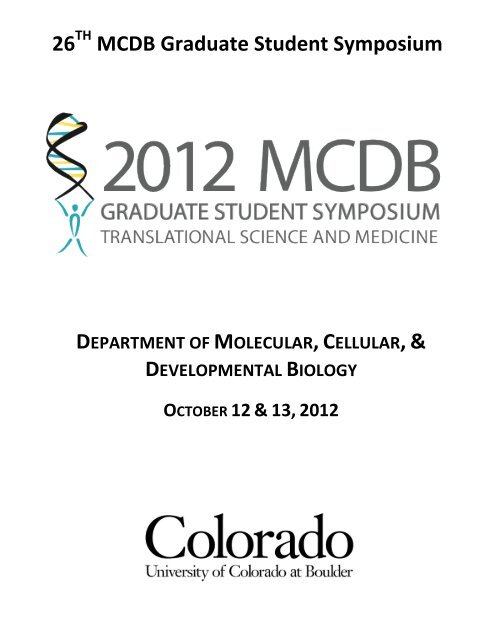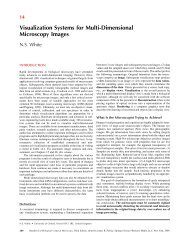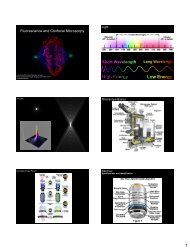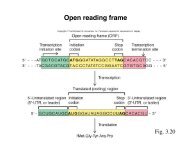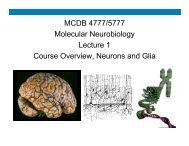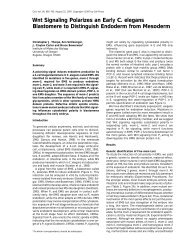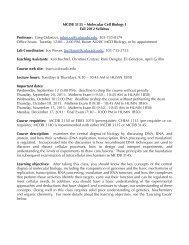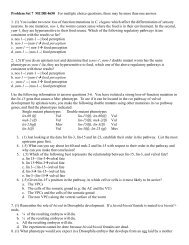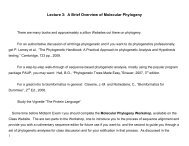2012 Program Booklet - MCD Biology - University of Colorado Boulder
2012 Program Booklet - MCD Biology - University of Colorado Boulder
2012 Program Booklet - MCD Biology - University of Colorado Boulder
You also want an ePaper? Increase the reach of your titles
YUMPU automatically turns print PDFs into web optimized ePapers that Google loves.
26 TH <strong>MCD</strong>B Graduate Student Symposium<br />
DEPARTMENT OF MOLECULAR, CELLULAR, &<br />
DEVELOPMENTAL BIOLOGY<br />
OCTOBER 12 & 13, <strong>2012</strong>
Welcome<br />
The <strong>MCD</strong>B Graduate Student Symposium is a biennial event held since<br />
1979 that brings together leading researchers in both academic fields and<br />
cutting-‐edge biotechnology enterprises for two days <strong>of</strong> stimulating talks<br />
and interaction between members <strong>of</strong> our local scientific community.<br />
The symposium is entirely student-‐organized, and as such, all the<br />
planning and fundraising is conducted solely by graduate students. We<br />
are delighted to announce the 26th <strong>MCD</strong>B Graduate Student Symposium<br />
on Translational Science and Medicine. The symposium will be held on<br />
October 12-‐13, <strong>2012</strong> at the new Jennie Smoly Caruthers Biotechnology<br />
Building at CU-‐<strong>Boulder</strong>. It will begin with a keynote speaker and reception<br />
on Friday evening, followed by several sessions on Saturday. We are<br />
delighted that you will be participating during this enjoyable weekend <strong>of</strong><br />
science and discussion.<br />
Sincerely,<br />
<strong>MCD</strong>B Graduate Student Symposium Committee<br />
Carolina Daez, Kent Riemondy and Tess Shideler
Past <strong>MCD</strong>B Graduate Student Symposia<br />
1979 Membranes<br />
1980 Cell Motility<br />
1981 The Accuracy <strong>of</strong> Biological Processes<br />
1983 Evolution: Shaping Molecules, Microbes, and Complex<br />
Organisms<br />
1984 Contemporary Research in Plant <strong>Biology</strong><br />
1985 The Role <strong>of</strong> Complex Carbohydrates in Cellular Function<br />
1987 Sex Determination<br />
1989 Pathogen Strategies: Evasion and Suppression <strong>of</strong> the Immune<br />
System<br />
1990 Life at the Edge: From Prebiotic Chemistry to<br />
Extraterrestrial <strong>Biology</strong><br />
1991 Zen and the Art <strong>of</strong> Cell Cycle Maintenance<br />
1992 Evolution from the inside<br />
1993 The Self-‐Wiring Machine: Development and Functional Organ<br />
Systems<br />
1994 The Human Genome<br />
1995 Self vs. Non-‐Self: Modes <strong>of</strong> Organismal Recognition<br />
1996 Pattern and Polarity: Establishing Difference in Development<br />
1997 Chromatin Structure and Gene Expression: Beyond the<br />
Double Helix<br />
1998 The Molecular Mechanisms <strong>of</strong> Cellular Motility<br />
1999 <strong>Program</strong>med Cell Death: Making a Graceful Exit<br />
2000 Astrobiology: Life in the Universe<br />
2002 Genomics and Beyond: DNA tells all?<br />
2004 Cancer <strong>Biology</strong><br />
2006 Stem Cell <strong>Biology</strong><br />
2008 Infectious Disease and Host-‐Pathogen Interactions<br />
2010 Neuroscience
Agenda<br />
Friday, October 12, <strong>2012</strong><br />
Time Location Event<br />
4.00-‐5.00 pm Butcher Atrium Registration<br />
5.00-‐5.10 pm Butcher Auditorium Welcome<br />
5.10-‐6.10 pm Butcher Auditorium Keynote: Bill Freytag<br />
6.10-‐6.55 pm Butcher Auditorium Jennifer Leeds<br />
6.55-‐9.00 pm Butcher Atrium Dinner & Reception<br />
Saturday, October 13, <strong>2012</strong><br />
Time Location Event<br />
8.00-‐9.00 am Butcher Atrium Breakfast and late<br />
Registration<br />
9.00-‐9.30 am Butcher Auditorium Keynote: Larry Gold<br />
9.30-‐10.15 am Butcher Auditorium Michael Yaffe<br />
10.15-‐10.35 am Butcher Atrium C<strong>of</strong>fee Break<br />
10.35-‐11:20 am Butcher Auditorium William Marshall<br />
11.20-‐12.05 pm Butcher Auditorium Stephen A. Williams<br />
12:05-‐1.15 pm Butcher Atrium Lunch and Vendor<br />
Exhibition<br />
1.15-‐2.00 pm Butcher Auditorium JoAnne Flynn<br />
2.00-‐2.45 pm Butcher Auditorium John T. Schiller<br />
2.45-‐3.15 pm Butcher Atrium C<strong>of</strong>fee Break<br />
3.15-‐4.00 pm Butcher Auditorium Jeffrey Settleman<br />
4.00-‐4.45 pm Butcher Auditorium Peter Jackson<br />
4.45-‐5.30 pm Butcher Auditorium William Sullivan<br />
5.30-‐7.00 pm Butcher Atrium Reception
Keynote Speaker:<br />
William Freytag, PhD<br />
Former Chairman and CEO, Myogen,<br />
<strong>Boulder</strong>, CO<br />
Title: Fifteen Years and $1.3 Billion Later<br />
Friday, October 12<br />
5:10 – 6:10 pm<br />
JSCBB Butcher Auditorium<br />
Abstract:<br />
It is the mission <strong>of</strong> pharmaceutical research companies to take the path from understanding a<br />
disease to bringing a safe and effective new treatment to patients. Scientists work to piece<br />
together the basic causes <strong>of</strong> disease at the level <strong>of</strong> genes, proteins and cells. Out <strong>of</strong> this<br />
understanding emerge “targets”, which potential new drugs might be able to<br />
affect. Researchers work to: (i) validate these targets, (ii) discover molecules (potential drug)<br />
that interact with the chosen target, (iii) test these new compounds in the lab and clinic for<br />
safety and efficacy, and (iv) gain regulatory approval and get the drug into the hands <strong>of</strong><br />
doctors and patients. This whole process typically takes 10-‐15 years and an expenditure <strong>of</strong><br />
$1.3 billion.
Jennifer Leeds, PhD<br />
Executive Director-‐ Antibacterial Discovery<br />
Infectious Diseases Area<br />
Novartis Institute for BioMedical Research<br />
Title: Discovery and development <strong>of</strong> LFF571, a<br />
novel antibacterial for the treatment <strong>of</strong> C.<br />
difficile infection.<br />
Friday, October 12<br />
6.10-‐6.55 pm<br />
JSCBB Butcher Auditorium<br />
Abstract:<br />
Antibiotics are among the most important advances in the history <strong>of</strong> modern medicine.<br />
Antibiotics transform deadly bacterial infections into curable diseases, and enable surgical and<br />
medical innovation in nearly every therapeutic area. However, the increasing use <strong>of</strong><br />
antibiotics has contributed to the rise in drug resistant and multi-‐drug resistant pathogens<br />
both in the community and in the hospital setting. At the same time, the number <strong>of</strong> new<br />
agents to treat bacterial infections is diminishing, partly due to the difficulty in identifying ideal<br />
targets and chemical starting points as well as increasing challenges in treating patients with<br />
complex medical needs. New agents should be potent against organisms exhibiting clinically-‐<br />
relevant drug resistant phenotypes. The discovery <strong>of</strong> new chemical entities targeting<br />
unexploited mechanisms <strong>of</strong> growth inhibition is one strategy to address this hurdle. This was<br />
the origin <strong>of</strong> the drug discovery program that led us to discover LFF571. LFF571 is a new<br />
chemical entity that is currently being evaluated for safety and efficacy in patients with<br />
Clostridium difficile infection. The discovery and early development program for this novel<br />
compound will be presented.
Keynote Speaker:<br />
Larry Gold, PhD<br />
Chairman, Founder, and CEO <strong>of</strong> SomaLogic<br />
Founder <strong>of</strong> NeXstar and Synergen<br />
Title: Empowering Students: The Good and<br />
the Ugly<br />
Saturday, October 13<br />
9:00 – 9:30 am<br />
JSCBB Butcher Auditorium<br />
Abstract:<br />
In 1973 or thereabouts Charlie Yegian died <strong>of</strong> leukemia. Charlie was a young pr<strong>of</strong>essor in<br />
<strong>MCD</strong>B, he was my friend, and I missed him immediately and still miss him. He was a great<br />
teacheer. Jane Westlye and I arranged a Symposium to honor Charlie. It was a great<br />
Symposium. One <strong>of</strong> the speakers said about Charlie that "when he did an experiment it stayed<br />
done." There is no higher accolade for a scientist.<br />
I then had an idea, which was simple. We could continue to have Symposia like the one we<br />
had to honor Charlie, and I could help the students raise money (my specialty, apparently) and<br />
they could do the work and share the learning that came with putting on a science<br />
symposium. We have had great student-‐driven symposia and some that were just OK -‐ that is<br />
as it should be. We always have had good people come to speak. The tension (The Good and<br />
the Ugly") is built into the activity, and it has to be there. Students are young, and they have<br />
ideas that are, say, in progress -‐ that has to be there. Students posture, unlike faculty, who<br />
never posture.
Michael B. Yaffe, PhD<br />
Pr<strong>of</strong>essor, Department <strong>of</strong> <strong>Biology</strong><br />
Massachusetts Institute <strong>of</strong> Technology (MIT)<br />
Title: Systems <strong>Biology</strong> Approaches to<br />
Optimizing Cancer Treatment<br />
Saturday, October 13<br />
9:20 – 10:15 am<br />
JSCBB Butcher Auditorium<br />
Abstract:<br />
Most current anti-‐cancer drugs function by one <strong>of</strong> two general mechanisms: (1) targeting specific signaling<br />
molecules, particularly protein kinases and growth factor receptors; and (2) inducing cytotoxicity through DNA<br />
damage or disruption <strong>of</strong> the mitotic spindle. Targeted agents/signaling inhibitors, when used as<br />
monotherapies for cancer treatment are non-‐curative. Although these drugs can induce dramatic tumor<br />
regression, and occasionally prolonged remissions, the cancers invariably recur. Alternatively, cytotoxic<br />
therapies that damage DNA have a long history <strong>of</strong> successful use as anti-‐neoplastic agents. However, patient<br />
responses to DNA damaging drugs vary greatly, and heterogeneity within any single tumor can lead to the<br />
emergence <strong>of</strong> a resistant sub-‐population <strong>of</strong> cells. The DNA damage from exposure <strong>of</strong> tumor cells to these<br />
cytotoxic agents is processed by a complex interacting network <strong>of</strong> signaling pathways involving protein<br />
kinases, phosphoserine/ threonine-‐binding domains (14-‐3-‐3 proteins, FHA domains, BRCT domains), and<br />
ubiquitin/SUMO modifying enzymes. The outputs <strong>of</strong> these DNA damage-‐activated pathways must be<br />
integrated with additional extracellular and intracellular cues such as cytokines and growth factor signals to<br />
control the resulting cellular response – cell cycle arrest, DNA repair, apoptosis or senescence. How this array<br />
<strong>of</strong> diverse signals is functionally integrated and processed, and how these signal integration events can be<br />
influenced by combinations <strong>of</strong> anti-‐cancer therapies to enhance tumor cell killing is unknown.<br />
To address this, we have been developing systems biology-‐based models <strong>of</strong> DNA damage signaling<br />
where gene expression signatures, kinase activities, protein phosphorylation, and phosphoprotein-‐binding<br />
events for multiple signaling pathways are quantitatively measured at densely sampled points in time, along<br />
with cellular responses such as cell cycle arrest, autophagy, and apoptosis. The resulting large dataset <strong>of</strong><br />
signals and responses are then related to each other mathematically using partial least squares regression,<br />
principal components analysis, and time-‐interval stepwise regression. We have used this approach to examine<br />
the response <strong>of</strong> breast cancer and osteosarcoma cells to DNA damaging chemotherapy and gamma radiation<br />
in the presence or absence <strong>of</strong> small molecule inhibitors <strong>of</strong> growth factor signaling pathways. The resulting<br />
models, built from thousands <strong>of</strong> signaling measurements and hundreds <strong>of</strong> cellular response assays, reveals<br />
surprisingly paradoxical context-‐dependent roles for the MEK-‐Erk and p38/MK2 kinase signaling pathways in<br />
controlling cell cycle arrest, apoptosis and senescence after DNA damage. Using this approach, we recently<br />
identified a novel time-‐staggered combination therapy in which EGFR inhibitor pre-‐treatment is used to<br />
dramatically enhance DNA damage-‐induced cell death in a subset <strong>of</strong> triple-‐negative breast cancers by dynamic<br />
re-‐wiring <strong>of</strong> apoptosis pathways. The results from these systems-‐based studies illustrate the importance <strong>of</strong><br />
measuring time-‐dependent changes in signaling pathways in evaluating and optimizing the effects <strong>of</strong> anti-‐<br />
cancer drugs, and show the utility <strong>of</strong> a new concept – therapeutic network re-‐wiring – in designing novel<br />
combination therapies with greater anti-‐tumor efficacy.
William S. Marshall, PhD<br />
President and Chief Executive Officer<br />
miRagen Therapeutics, Inc.<br />
Title: microRNA targeting as a novel approach<br />
to the development <strong>of</strong> cardiovascular<br />
therapeutics<br />
Saturday, October 13<br />
10:35 – 11:20 am<br />
JSCBB Butcher Auditorium<br />
Abstract:<br />
Alterations in the expression <strong>of</strong> specific microRNAs have been observed in several<br />
cardiovascular disease models and human clinical samples, providing an exciting potential for<br />
therapeutic intervention. Genetic deletion studies that have been recapitulated by synthetic<br />
antimiR dosing studies demonstrated that the inhibition <strong>of</strong> certain microRNA’s is sufficient to<br />
produce beneficial outcomes in relevant disease models. Targeting such microRNAs with<br />
short, high-‐affinity oligonucleotides has demonstrated significant promise, as this strategy<br />
benefits from the altered biophysical properties <strong>of</strong> the antimiR compared to traditional<br />
antisense or RNAi gene targeting approaches. These characteristics contribute to enhanced<br />
pharmaceutical properties <strong>of</strong> the antimiR. An overview <strong>of</strong> our lead programs will highlight<br />
several key pharmacological observations that help build confidence in the lead molecules as<br />
they advance towards human clinical evaluation.
Steven A. Williams, PhD<br />
Chief Medical Officer<br />
SomaLogic<br />
Title: The Voices <strong>of</strong> Life; Discovery <strong>of</strong> Protein<br />
Patterns in Health and Disease Using<br />
SOMAmers<br />
Saturday, October 13<br />
11:20 – 12:05 pm<br />
JSCBB Butcher Auditorium<br />
Abstract:<br />
Despite the exciting promises being made about personalized medicine enabled by genetic<br />
testing, it is an impossible task. This is because the environment is not genetic, and yet has a<br />
big (or perhaps I should say "supersize") influence on health and disease, and because outside<br />
<strong>of</strong> a cancer our genetics don't significantly change from the time when we are babies to the<br />
day we die. The ideal health measurement would be <strong>of</strong> low cost and would respond to both<br />
environment and changes in health status. Proteins -‐ as the downstream product <strong>of</strong> genetics<br />
and environment -‐ have the right characteristics but the available technologies have not been<br />
up to the task <strong>of</strong> measuring thousands <strong>of</strong> them across a difference in abundance from the<br />
lowest to the highest <strong>of</strong> tens <strong>of</strong> billions to one. A new type <strong>of</strong> reagent will be described -‐ the<br />
SOMAmer -‐ which has enabled us to overcome these issues, and which has driven<br />
unprecedented discoveries. Examples will be shown from the early detection <strong>of</strong> cancer!<br />
to cardiovascular disease, and how individual tests can be bundled together to enable the<br />
"wellness chip", with the intention <strong>of</strong> lowering the cost <strong>of</strong> healthcare and improving health<br />
outcomes.
JoAnne Flynn, PhD<br />
Pr<strong>of</strong>essor, Department <strong>of</strong> Microbiology and<br />
Molecular Genetics<br />
<strong>University</strong> <strong>of</strong> Pittsburgh School <strong>of</strong> Medicine<br />
Title: Tuberculosis: Seeing is Believing<br />
Saturday, October 13<br />
1:15 – 2:00 pm<br />
JSCBB Butcher Auditorium<br />
Abstract:<br />
Tuberculosis is caused by Mycobacterium tuberculosis. Humans infected with this bacillus can<br />
present with active TB (symptomatic) or clinically latent (asymptomatic) infection. The factors<br />
that determine the outcome <strong>of</strong> infection are not fully understood. Active TB can present in a<br />
variety <strong>of</strong> ways, from mild to fulminant disease. Recently, we have proposed that latent<br />
infection also represents a spectrum <strong>of</strong> infections, and those that are “higher” on the<br />
spectrum <strong>of</strong> latency are more likely to develop reactivation TB. Using a non-‐human primate<br />
model <strong>of</strong> tuberculosis, we have assessed the factors and events that influence outcome <strong>of</strong><br />
infection, and have used sophisticated whole-‐body imaging to track the infection. Our findings<br />
indicate that the spectrum <strong>of</strong> M. tuberculosis infection that exists in the population can also<br />
exist in a single host. Using imaging, immunology, bacteriology and modeling, we have data to<br />
demonstrate the heterogeneity <strong>of</strong> infection within a single host at the level <strong>of</strong> the granuloma.<br />
Data on the variability in granulomas will be presented. This variability has implications for<br />
development <strong>of</strong> drugs to effectively and efficiently treat tuberculosis, as well as vaccines to<br />
prevent infection or disease.
John T. Schiller, PhD<br />
Head, Neoplastic Disease Section<br />
Deputy Laboratory Chief<br />
Laboratory <strong>of</strong> Cellular Oncology<br />
National Cancer Institute, Bethesda, MD.<br />
Title: Understanding and Learning from the<br />
Success <strong>of</strong> Human Papillomavirus Prophylactic<br />
Vaccines<br />
Saturday, October 13<br />
2:00 – 2:45 pm<br />
JSCBB Butcher Auditorium<br />
Abstract:<br />
The development <strong>of</strong> antimicrobial vaccines is undoubtedly one <strong>of</strong> the greatest triumphs <strong>of</strong><br />
biomedical research. Given the extraordinary effectiveness <strong>of</strong> vaccines against a wide array <strong>of</strong><br />
bacterial and viral pathogens, the failure to develop effective vaccines against the most<br />
common sexually transmitted infections, especially HIV, has been both surprising and<br />
frustrating. The only notable exception is the development <strong>of</strong> prophylactic vaccines against<br />
genital human papillomaviruses (HPVs), the primary etiologic agents in an estimated 5% <strong>of</strong><br />
human cancers, most importantly cervical cancer. In recently concluded clinical trials, the<br />
vaccines were safe and very effective at preventing sexually transmitted infection and the<br />
neoplastic diseases induced by the HPV types targeted by the vaccines. They are now licensed<br />
in many countries worldwide for the prevention <strong>of</strong> cervical and other HPV-‐associated cancers<br />
and various other hyperproliferative diseases. It is therefore interesting to examine why the<br />
HPV vaccines have succeeded whereas those targeting other sexually transmitted infections<br />
(STIs) have failed. In this seminar, I will briefly review the association <strong>of</strong> HPVs with human<br />
cancer and other neoplastic diseases, describe the composition <strong>of</strong> the two commercial<br />
vaccines and summarize their efficacy in clinical trials and their emerging effectiveness in<br />
general vaccination programs. Specific aspects <strong>of</strong> HPV molecular biology and vaccine<br />
composition that likely contribute to their remarkable success will then be discussed. Finally, I<br />
will speculate on how the lessons learned from the HPV vaccines might influence the future <strong>of</strong><br />
vaccine development for other STIs, particularly HIV and herpes simplex.
Jeffrey Settleman, PhD<br />
Senior Director, Discovery Oncology<br />
Genentech<br />
Title: The Many Flavors <strong>of</strong> Resistance to<br />
Anti-‐Cancer Drugs<br />
Saturday, October 13<br />
3:15 – 4:00 pm<br />
JSCBB Butcher Auditorium<br />
Abstract:<br />
The recent clinical success experienced with several “rationally-‐targeted” anti-‐cancer drugs, such as<br />
the kinase inhibitors imatinib, erlotinib, crizotinib, and vemurafenib, has defined a paradigm shift in<br />
cancer therapy. However, despite the sometimes impressive clinical activity associated with these<br />
agents, progression during therapy is inevitable due to the acquisition <strong>of</strong> drug resistance. For many<br />
drugs, specific genetic mechanisms <strong>of</strong> resistance have been elucidated, and pre-‐clinical findings<br />
implicate additional non-‐genetic mechanisms. Moreover, accumulating evidence implicates<br />
heterogeneity within cancer cell populations in the response to drug treatment, posing an additional<br />
challenge to the development <strong>of</strong> effective cancer therapeutics.<br />
While modeling the acute response to various anti-‐cancer agents in drug-‐sensitive tumor cell lines, we<br />
consistently observed a small subpopulation <strong>of</strong> reversibly “drug-‐tolerant” cells. This drug-‐tolerant<br />
phenotype, associated with a distinct chromatin state, is transiently acquired and relinquished at low<br />
frequency by individual cells within the population, implicating the dynamic regulation <strong>of</strong> phenotypic<br />
heterogeneity in drug tolerance. The drug-‐tolerant subpopulation can be selectively ablated by<br />
treatment with chromatin-‐modifying agents, potentially yielding a therapeutic opportunity. These<br />
findings suggest that cancer cell populations employ an epigenetically-‐regulated dynamic survival<br />
strategy in which individual cells transiently assume a reversibly drug-‐tolerant state to protect the<br />
population from eradication by potentially lethal exposures.<br />
Cancer cells typically express multiple receptor tyrosine kinases (RTKs) that mediate signals that<br />
converge on common critical downstream cell survival effectors -‐ most notably, phosphatidylinositol<br />
3-‐kinase and mitogen-‐activated protein kinase. Consequently, increased RTK ligand levels, via<br />
autocrine tumor cell production, paracrine contribution by tumor stroma, or systemic production,<br />
could confer resistance to inhibitors <strong>of</strong> an oncogenic kinase with a similar signaling output. Using a<br />
panel <strong>of</strong> kinase-‐“addicted” cancer cell lines, we found that most cells can be “rescued” from drug<br />
sensitivity by simply exposing them to one or more RTK ligands. Among the findings with clinical<br />
implications was the observation that hepatocyte growth factor confers resistance to the BRAF<br />
inhibitor vemurafenib in BRAF mutant melanoma cells. These observations highlight the extensive<br />
redundancy <strong>of</strong> RTK-‐transduced signalling in cancer cells and the potentially broad role <strong>of</strong> widely<br />
expressed RTK ligands in innate and acquired resistance to drugs targeting oncogenic kinases.
Peter Jackson, PhD<br />
Staff Scientist: Research Oncology<br />
Genentech<br />
Saturday, October 13<br />
4:00 – 4:45 pm<br />
JSCBB Butcher Auditorium<br />
Research Focus:<br />
My laboratory has worked on the biochemistry <strong>of</strong> the cell cycle, including DNA replication and<br />
mitosis. Much <strong>of</strong> our effort has gone toward understanding how proteolytic degradation by<br />
the ubiquitin proteasome system regulates the cell cycle.<br />
We have made key contributions to understanding how proteins that regulate the cell cycle,<br />
called cyclins, accumulate and are destroyed in vertebrate cells and in eggs. A central finding<br />
was our discovery <strong>of</strong> inhibitors <strong>of</strong> E3 ubiquitin ligases and their role in cell cycle control. We<br />
have identified several critical factors regulating cyclins and have linked their misregulation to<br />
cancer, proliferative disease and senescence. We continue to define important regulators in<br />
mitosis and in the ubiquitin pathway.<br />
Our recent work has also focused on signaling through the primary cilium. The primary cilium<br />
is an organelle with critical roles in signaling in tissues including the retina, nervous system,<br />
kidney and sensory organs. The importance <strong>of</strong> the cilia in signaling was only recently<br />
appreciated, but this structure organizes a still unknown number <strong>of</strong> receptor systems. These<br />
pathways are genetically linked to important degenerative diseases including renal cystic<br />
disease, obesity, diabetes, retinopathies and cancer signaling. We have used proteomic<br />
approaches to define regulatory networks linked to proteins that are defective in human<br />
diseases called ciliopathies. We are looking for critical receptor classes linked to these diseases<br />
and evaluating the therapeutic opportunities presented by these receptors
William Sullivan, PhD<br />
Pr<strong>of</strong>essor, Department <strong>of</strong> Molecular, Cell &<br />
Developmental <strong>Biology</strong><br />
<strong>University</strong> <strong>of</strong> California, Santa Cruz (UCSC)<br />
Title: Wolbachia, African River Blindness, and<br />
Big Sur<br />
Saturday, October 13<br />
4:45 – 5:30 pm<br />
JSCBB Butcher Auditorium<br />
Abstract:<br />
Wolbachia are obligate, intracellular, bacterial endosymbionts present in over 60% <strong>of</strong> all insect<br />
species. Manipulation <strong>of</strong> host reproduction and efficient maternal transmission have<br />
facilitated the global spread <strong>of</strong> Wolbachia in arthropods. Wolbachia are also present in filarial<br />
nematodes and are the leading cause <strong>of</strong> River Blindness and Elephantiasis. Our lab has<br />
focussed on the molecular and cellular interactions that mediate Wolbachia replication and<br />
transmission through insect and nematode germlines. Our studies demonstrate that efficient<br />
germline transmission <strong>of</strong> Wolbachia requires a developmentally coordinated association with<br />
plus and minus end motor proteins followed by a stable association in conserved germline<br />
determinants. In addition, Wolbachia manipulates host chromatin remodelers and the cell<br />
cycle to its advantage. Surveys <strong>of</strong> wild Drosophila populations reveals Wolbachia also stably<br />
populates host somatic lineages including the adult brain. Consequently we were able to<br />
generate stably Wolbachiainfected Drosophila cell lines. This facilitated high-‐throughput cell-‐<br />
based screens for small molecule compounds that specifically target Wolbachia. We descrbe<br />
the identification <strong>of</strong> Albendazole sulfone, an FDA approved metabolite <strong>of</strong> Albendazole, that<br />
specifically disrupts Wolbachia replication in Brugia malayi, the nematode associated with<br />
Elephantiasis and<br />
River Blindness.
Acknowledgements<br />
The <strong>MCD</strong>B Graduate Student Symposium is a collaborative effort that would not<br />
be possible without the contributions <strong>of</strong> numerous individuals including<br />
undergraduate and graduate students, faculty and staff. Their dedication and<br />
enthusiasm has helped shape the engaging and collaborative environment found<br />
in the <strong>MCD</strong>B department.<br />
Special Thanks:<br />
Wendi Howard, Lee Gutmacher and Jaime Birren: Finance assistance<br />
Kathy Lozier: Travel arrangements and event logistics<br />
Karen Brown: Event logistics<br />
Laura Garret (SOFO): Budget coordination<br />
Erik Hedl and Alex Laszlo Bagi: Website design and registration databases<br />
Jessica Daez: Symposium logo design<br />
Vicky Romano and Lee Silbert: JSC Biotechnology venue coordination<br />
Ken Krauter: Graduate student mentor<br />
Elizabeth O'Connell (Front Range Catering Company): Catering and rentals<br />
In addition, special thanks to the numerous volunteers:<br />
Every two years, the graduate students in the <strong>MCD</strong>B department at the <strong>University</strong><br />
<strong>of</strong> <strong>Colorado</strong>, <strong>Boulder</strong> organize a scientific symposium. We are delighted that an<br />
overwhelming number <strong>of</strong> undergraduate and graduate students have volunteered<br />
their time and talents to help with this year’s symposium. Students helped<br />
coordinate the entire event, including choosing this year’s topic, inviting speakers<br />
and helping with the logistical planning. The result is a day and a half <strong>of</strong><br />
stimulating talks and interaction between members <strong>of</strong> our scientific community.<br />
<strong>2012</strong> Graduate Student Symposium Organizing Committee:<br />
Carolina Daez (3rd year, Winey lab)<br />
Kent Riemondy (5th year, Yi Lab)<br />
Tess Shideler (6th year, Odorizzi lab)<br />
In memoriam:<br />
Dr. David M Prescott Distinguished Pr<strong>of</strong>essor Emeritus <strong>MCD</strong>B 1926-‐2011<br />
Dr. Richard Ham Pr<strong>of</strong>essor Emeritus <strong>MCD</strong>B 1932-‐2011
Symposium Location<br />
Jennie Smoly Caruthers Biotechnology Building<br />
Butcher Auditorium<br />
<strong>University</strong> <strong>of</strong> <strong>Colorado</strong>, <strong>Boulder</strong><br />
3415 <strong>Colorado</strong> Ave.,<br />
<strong>Boulder</strong> CO 80303<br />
Symposium Parking Map
<strong>2012</strong> PRESENTING SPONSORS
<strong>2012</strong> PRESENTING SPONSORS<br />
Arts and Science Student Government (ASSG)<br />
Center for the Integrative Study <strong>of</strong> Work in Living Systems,<br />
UCB<br />
Council <strong>of</strong> Colleges and Schools (CCS)<br />
Student Group Funding Board (SGFB)<br />
Vice Chancellor for Student Affairs (VCSA)<br />
<strong>MCD</strong>B Undergraduate Club<br />
NIH Institutional Training Grant<br />
"Creative Training in Molecular <strong>Biology</strong>" GM-07135<br />
The Department <strong>of</strong> Molecular, Cellular<br />
and Developmental <strong>Biology</strong>
Notes:


